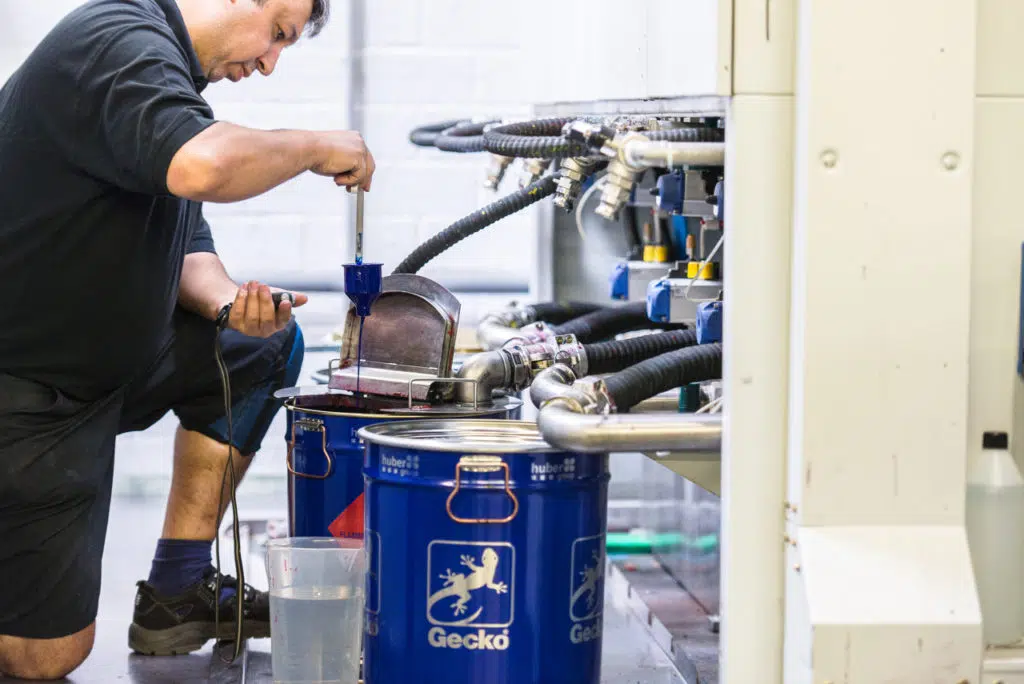Flexo, the agile print partner for brands in 2020
Brands have been beset with challenges in 2020 as the global response to Covid-19 has continued. For some, business has increased, and quickly, but for all there has been rapid changes and uncertainty. Martin Dreher of the DFTA, Ken McGuire from P&G, and flexo specialist Sebastian Longo discuss how flexo technology has helped brands respond…
Professor Dr Martin Dreher at the DFTA – the German flexographic printing association – describes the impact of Covid-19 as “selective” for the contacts he has spoken to since the pandemic response began. “There are certainly companies that have suffered but also quite a lot that have benefited from how consumers have responded and retail trends.”
Martin says that the ability for flexo to economically print at a high quality on shorter print runs has been key to brands so far in 2020, while the long lead time and large quantities of substrate needed for gravure are likely to have hampered that process as an approach for changing demands.
“The whitepaper we have produced this year – a reference work for packaging printing – has really shown how well flexo performs on the quality level compared to other processes.
“But, time to market is the key phrase for brand owners. Once they have agreed their design they want it to be on the shelf the next day. That might not be possible but we are talking days, and even if we compare it to digital, if you have a flexo press available you can make flexo plates today within hours and theoretically deliver material the next day.”

A long-run trend towards shorter print runs hasn’t abated as a result of the crisis. Martin says that brands have remained focused on smaller volumes, partly a result of uncertainty on what the next stage in the pandemic response might be. Other factors that are more established also persist: fragmented print runs due to product line variation, warehousing and monetary reasons for limiting the storage of stock and packaging materials.
“There’s been a tremendous move from rotogravure to flexo as the quality of flexo has gotten better. And the reasons are obvious.”
Ken McGuire, Research Fellow in Proctor and Gamble’s corporate R&D department, commented at the end of last year on how brands were moving towards flexo for its agility in responding to merchandising or consumer changes.
“We want costs to be driven down but quality to stay high, so it gets to a place where it can be ubiquitous,” he said.
“The reason? Our brands would frequently like to be able to do two things: 1. print on demand, so we’ll be able to take advantage of promotions etc. 2. Change the outlook of a brand quickly so it has a fresh face when it needs one.
“There’s been a tremendous move from rotogravure to flexo as the quality of flexo has gotten better. And the reasons are obvious: plate storage is a whole lot more efficient, plate manufacture is a whole lot cheaper, and set up time and turnaround time can be lower.”
Unlocking responsive print
President of Fotograbados Longo Sebastian Longo, who has 30 years’ experience in the industry, says it was improvements to plate performance and plate life that helped make flexo a print partner for brands in meeting changing packaging demands.
“It takes all parts of the flexo value chain to work together in partnership to drive operational efficiency and sustainability together.”
Significant improvements that have taken place in flexo prepress continue to deliver higher output quality and productivity, and at a reasonable cost. He also highlights that innovation in one part of the flexo value chain supports and triggers the development of others:
“When Kodak introduced FLEXCEL NX, I thought Kodak was stepping back 10 years, because the approach was very different to what was happening in the flexo market. But when we all saw the printer results there was surprise. The quality was nice, the highlights were nice, through a different way of laying down ink.
“Innovations like these catalysed development in the flexo industry to make it more competitive with alternative printing methods, including offset, gravure and digital printing.”
“Flexo printing is unlike any other printing method and the challenges flexo printers face are complex and sometimes unpredictable. The method uses a range of different printing machine architectures, ink types and sequences, and a vast array of substrates.

“These variables must all be kept under control to achieve consistent output results. It takes all parts of the flexo value chain to work together in partnership to drive operational efficiency and sustainability together,” Sebastian adds.
Martin at the DFTA says, “people upstream, the brand owners, have been impressed by the flexibility and agility of modern flexo.” He adds that the process improvements achieved in flexo mean it can be an option for longer runs, as well as lower volume orders, with lots of potential to open up more benefits through growth in automation.
“In the last four months we have seen initiatives continue in press automation, we’ve seen what press manufacturers are doing in this area, and what we have found in our whitepaper is that this is a big area of potential for flexo, to develop automation.”
Solving shifting substrate demands
Substrates, whether due to supply constraints, or shifting priorities on the shop floor, have been a major part of the discussion the pandemic response, and its impact on packaging.
“Flexo has true flexibility in terms of substrate; it is forgiving and can print successfully in the same quality on lesser grade materials.”
Martin says the focus on developing new substrates and a move towards using fibre materials has been suspended into next year, or even into 2022, as short-term pressure has led to a renewed acceptance of plastic in packaging, largely for hygiene reasons.
The innovation in substrates, however, hasn’t gone away and Martin says flexo is well-placed to respond as demands change. “Flexo has true flexibility in terms of substrate; it is forgiving and can print successfully in the same quality on lesser grade materials. In the future, brands will be forced to look at barrier papers and fibre materials.”

He says the development of effective ink transfer in flexo through surface patterning of the plates (e.g. Kodak Digicap NX patterns) means very thin coatings can be applied to substrates – which is likely to be a need as innovation in substrates continues – but also in more immediate developments in packaging: exploring the use of antimicrobial coatings.
“There is a need to apply thin coatings effectively, single digit microns, as it’s very important to close the pinholes that can be created when ink is transferred,” he explains.
The challenges that have affected every part of the value chain so far in 2020 have been many and varied, from making workplaces safe, and managing supply chains through to responding to a surge in home delivery. Flexo’s agility has enabled brands to respond to shifting packaging needs, with plenty of potential to continue meeting these needs as we move forward.
Find out more about the new DFTA white paper and their series of webinars on flexo
Discover more about the underlying technology at the heart of KODAK FLEXCEL NX Solutions
- Stories
Brand talk with Ken McGuire
Procter & Gamble’s Ken McGuire knows brands. And what they need. He talks start-up mentality, the power of packaging, sustainable thinking and what's next on brands' radars...
- Stories
Flexo trends and responses in crisis – a global round-up
As the response to the Covid-19 pandemic continues to evolve around the world, we’ve put together a list of recommended reading and watching from the global flexo and packaging industry to help with your own response and keep you informed.